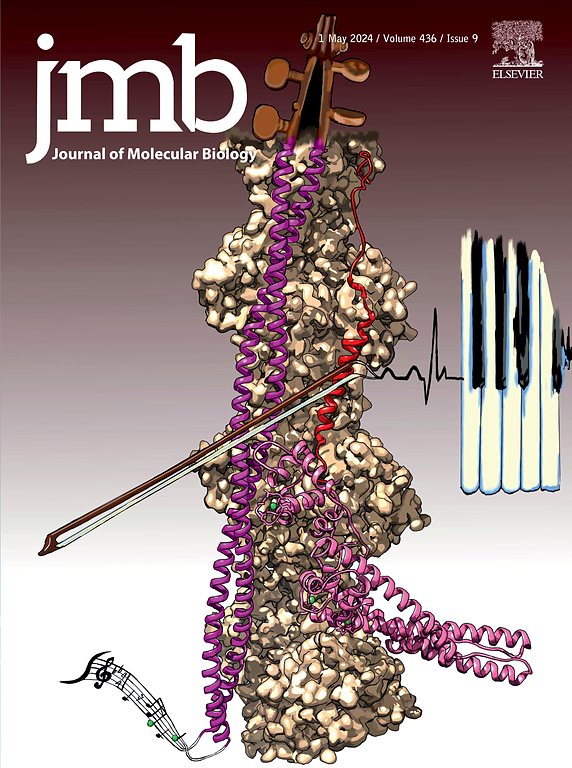DDX37 and DDX50 Maintain Genome Stability by Preventing Transcription-dependent R-loop Formation
IF 4.7
2区 生物学
Q1 BIOCHEMISTRY & MOLECULAR BIOLOGY
引用次数: 0
Abstract
R-loops consist of an RNA-DNA hybrid and a displaced single-stranded DNA strand that play a central role in several biological processes. However, as the presence of aberrant R-loops forms a significant threat to genome stability, R-loop formation and resolution is strictly controlled by RNAse H and helicases. In a screening for RNA helicases, previously described as RNA-DNA hybrid interactors, that control genome integrity, we identified for the first time DDX37 and DDX50. Depletion of DDX37 and DDX50 promotes DNA damage, as demonstrated by H2AX phosphorylation and increased comet tail length. In addition, knock down of these RNA helicases decreases the DNA replication track length and leads to RPA focus formation, results that are indicative of replication stress. Downregulation of DDX37 and DDX50 triggers an increase in RNA-DNA hybrids, that can be reverted by the overexpression of RNase H1. Interestingly, inhibition of transcription prevented the increased RNA-DNA hybrid formation and DNA damage upon DDX37 or DDX50 depletion. Together these results demonstrate that DDX37 and DDX50 are important for resolving RNA-DNA hybrids appearing during transcription and thereby preventing DNA damage by replication stress.

DDX37和DDX50通过阻止转录依赖性r环的形成来维持基因组的稳定性。
r环由RNA-DNA杂交和移位的单链DNA链组成,在几个生物过程中起着核心作用。然而,由于异常r环的存在对基因组稳定性构成重大威胁,r环的形成和分解受到RNAse H和解旋酶的严格控制。在筛选RNA解旋酶(以前被描述为RNA- dna杂交相互作用物,控制基因组完整性)时,我们首次鉴定出DDX37和DDX50。DDX37和DDX50的缺失促进了DNA损伤,H2AX磷酸化和彗尾长度增加证明了这一点。此外,敲除这些RNA解旋酶会减少DNA复制轨迹的长度并导致RPA焦点的形成,结果表明复制应激。DDX37和DDX50的下调触发RNA-DNA杂交体的增加,这可以通过RNase H1的过表达来逆转。有趣的是,转录抑制阻止了DDX37或DDX50缺失时RNA-DNA杂交形成和DNA损伤的增加。这些结果表明,DDX37和DDX50对于解决转录过程中出现的RNA-DNA杂交体,从而防止复制胁迫造成的DNA损伤具有重要作用。
本文章由计算机程序翻译,如有差异,请以英文原文为准。
求助全文
约1分钟内获得全文
求助全文
来源期刊

Journal of Molecular Biology
生物-生化与分子生物学
CiteScore
11.30
自引率
1.80%
发文量
412
审稿时长
28 days
期刊介绍:
Journal of Molecular Biology (JMB) provides high quality, comprehensive and broad coverage in all areas of molecular biology. The journal publishes original scientific research papers that provide mechanistic and functional insights and report a significant advance to the field. The journal encourages the submission of multidisciplinary studies that use complementary experimental and computational approaches to address challenging biological questions.
Research areas include but are not limited to: Biomolecular interactions, signaling networks, systems biology; Cell cycle, cell growth, cell differentiation; Cell death, autophagy; Cell signaling and regulation; Chemical biology; Computational biology, in combination with experimental studies; DNA replication, repair, and recombination; Development, regenerative biology, mechanistic and functional studies of stem cells; Epigenetics, chromatin structure and function; Gene expression; Membrane processes, cell surface proteins and cell-cell interactions; Methodological advances, both experimental and theoretical, including databases; Microbiology, virology, and interactions with the host or environment; Microbiota mechanistic and functional studies; Nuclear organization; Post-translational modifications, proteomics; Processing and function of biologically important macromolecules and complexes; Molecular basis of disease; RNA processing, structure and functions of non-coding RNAs, transcription; Sorting, spatiotemporal organization, trafficking; Structural biology; Synthetic biology; Translation, protein folding, chaperones, protein degradation and quality control.
 求助内容:
求助内容: 应助结果提醒方式:
应助结果提醒方式:


